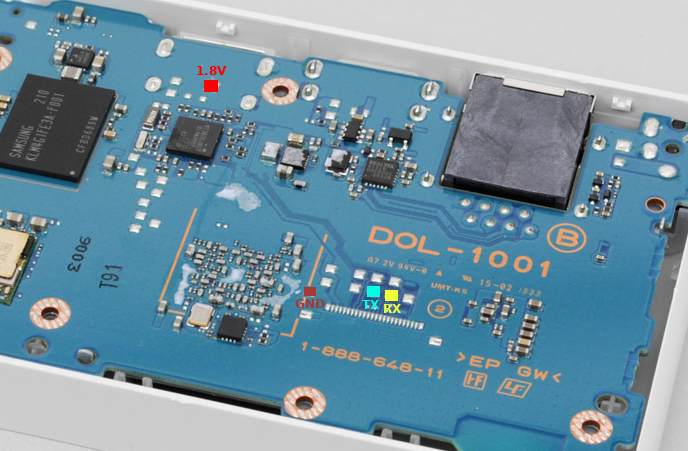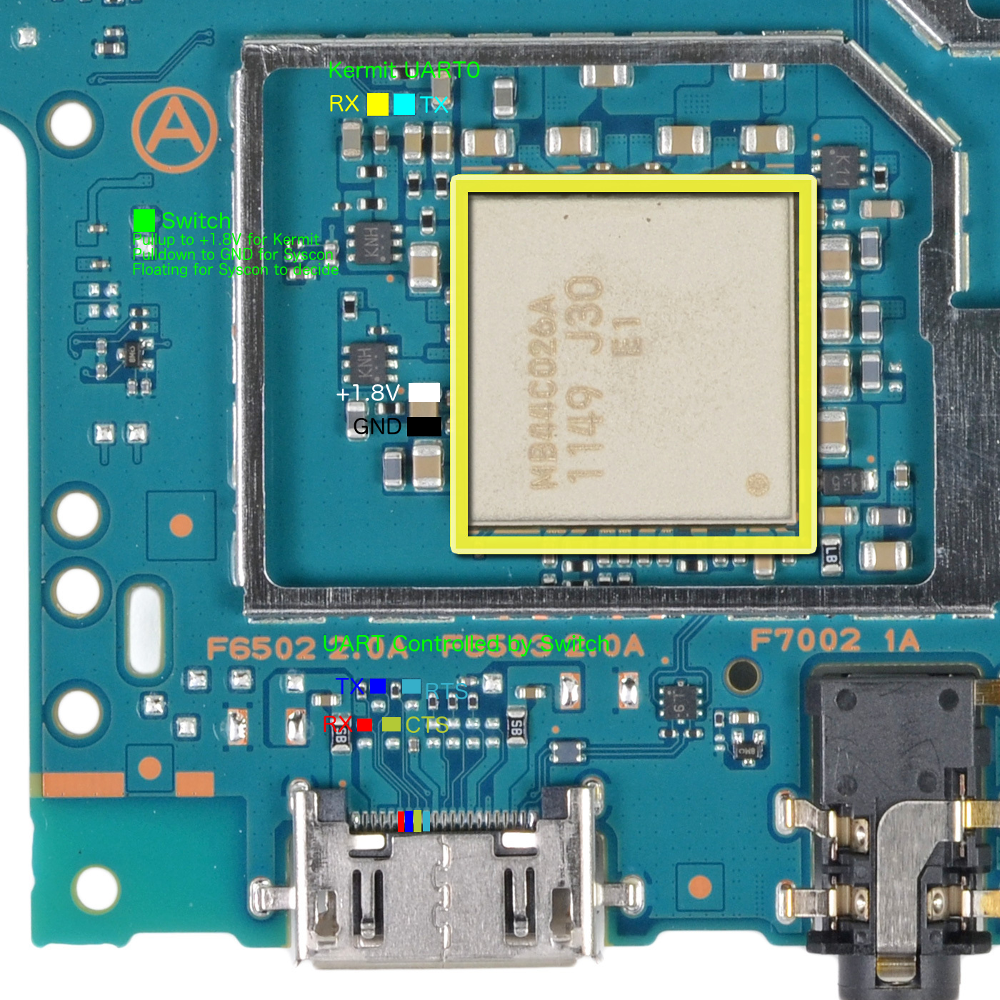UART Console: Difference between revisions
Jump to navigation
Jump to search
CelesteBlue (talk | contribs) |
CelesteBlue (talk | contribs) No edit summary |
||
| Line 1: | Line 1: | ||
== UART0 == | == UART0 == | ||
The UART0 is a debugging console. The logic level is 1.8V. | The UART0 is a debugging console used by ARM, cMep and Syscon. The logic level is 1.8V. | ||
=== PSTV UART0 location === | === PSTV UART0 location === | ||
[[File:Pstv_uart0.png]] | [[File:Pstv_uart0.png]] | ||
=== OLED PSVita UART0 location === | === OLED PSVita UART0 location === | ||
[[File:vita-1000-uart.png|600px]] | [[File:vita-1000-uart.png|600px]] | ||
| Line 12: | Line 14: | ||
* First way is to solder directly to the testpads near the PMIC (yellow and cyan points). | * First way is to solder directly to the testpads near the PMIC (yellow and cyan points). | ||
* Second way is through the multi-connector or the testpads above it (blue and red points). To use the multi-connector points though, you need either to tell | * Second way is through the multi-connector or the testpads above it (blue and red points). To use the multi-connector points though, you need either to tell Syscon to select [[Kermit]] UART (procedure currently unknown) or manually flip the switch (green point to 1.8V). | ||
The switch is controlled by a [http://www.ti.com/lit/ds/symlink/ts3a5018.pdf TS3A5018] chip and the RTS gate is a [http://toshiba.semicon-storage.com/ap-en/product/logic/one-gate-logic/detail.TC7WG126FK.html TC7WG126FK] chip. | The switch is controlled by a [http://www.ti.com/lit/ds/symlink/ts3a5018.pdf TS3A5018] chip and the RTS gate is a [http://toshiba.semicon-storage.com/ap-en/product/logic/one-gate-logic/detail.TC7WG126FK.html TC7WG126FK] chip. | ||
== UART5 == | == UART5 == | ||
The UART5 is a debugging console used for the 3G modem on PS Vita models that have it. | |||
=== OLED PSVita UART5 location === | === OLED PSVita UART5 location === | ||
It is on the PCI-E connector pins 8,10,12,14 is RFR, CTS, TX, RX. | It is on the PCI-E connector pins 8,10,12,14 is RFR, CTS, TX, RX. | ||
* On 3G | * On 3G PS Vita units, you can solder to the PCI-E connectors or install yifan lu's PSVSD board. | ||
* On Wifi | * On Wifi PS Vita units, you need to fill in the 88ohm termination resistors (or just short the pads) and some way to enable it (not known yet). | ||
== UART initialization/deinitialization code == | == UART initialization/deinitialization code == | ||
Revision as of 21:25, 30 August 2021
UART0
The UART0 is a debugging console used by ARM, cMep and Syscon. The logic level is 1.8V.
PSTV UART0 location
OLED PSVita UART0 location
There are two ways of using UART0:
- First way is to solder directly to the testpads near the PMIC (yellow and cyan points).
- Second way is through the multi-connector or the testpads above it (blue and red points). To use the multi-connector points though, you need either to tell Syscon to select Kermit UART (procedure currently unknown) or manually flip the switch (green point to 1.8V).
The switch is controlled by a TS3A5018 chip and the RTS gate is a TC7WG126FK chip.
UART5
The UART5 is a debugging console used for the 3G modem on PS Vita models that have it.
OLED PSVita UART5 location
It is on the PCI-E connector pins 8,10,12,14 is RFR, CTS, TX, RX.
- On 3G PS Vita units, you can solder to the PCI-E connectors or install yifan lu's PSVSD board.
- On Wifi PS Vita units, you need to fill in the 88ohm termination resistors (or just short the pads) and some way to enable it (not known yet).
UART initialization/deinitialization code
scePervasiveUartClockEnableForDriver(port); // Turn on clock
scePervasiveUartResetDisableForDriver(port); // Out of reset
sceUartInitForKernel(port);
/*
* Use UART port (read/write)
* ...
*/
scePervasiveUartResetEnableForDriver(port); // Put to reset
scePervasiveUartClockDisableForDriver(port); // Turn off clock
